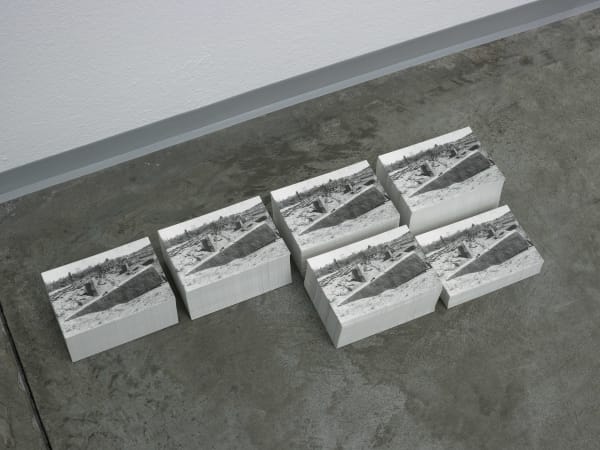Eighteen Exhibitions: Michael Müller
-
介绍
Teil 1. In Situ. Warum kann man Gedanken nicht sehen
April 6, 2013Teil 2. Ex Situ
April 6 − 20, 2013Teil 3. Prolog: Skizze einer Ausstellung. Vom Problem heute zeitgenössisch zu sein
April 10 − 20, 2013In April 2013, Michael Müller will launch his exhibition cycle, Achtzehn Ausstellungen (Eighteen Exhibitions), at Galerie Thomas Schulte. The first three exhibitions will be opened on two separate evenings, beginning on Friday, 5th of April 2013, with In Situ. Warum kann man Gedanken nicht sehen (In Situ. Why Thoughts Cannot Be Seen) and Ex Situ, followed by Prolog: Skizze einer Ausstellung. Vom Problem heute zeitgenössisch zu sein (Prologue: Sketch of an Exhibition. On the Problem of Being Contemporary Today) on Tuesday, 9th of April. While In Situ. Warum kann man Gedanken nicht sehen will only be on display for one day – Saturday, 6th of April – the other two exhibitions will be on until Saturday, 20th of April. The exhibition cycle will be continued in the fall of 2013 and will end in 2014.
The show bases itself on the 100-year anniversary of the year 1913, where Robert Musil’s, The Man Without Qualities, begins. Over 17 years ago, Michael Müller started to conceptually translate Musil’s novel into his own graphic handwriting, known as K4, based on horizontal and vertical lines, as well as segments of circles. A large portion of the transcribed book pages will adorn the walls of the gallery’s main room for the extent of the 15 exhibitions. In alternating shows and against this backdrop – that will be visible during some occasions and behind a curtain during others – Müller will present works and objects – some his own and some taken from other artists and non-artists – that are placed together in the context and atmosphere of Musil’s novel. Through the continuous roll reversals from artist to curator, Müller establishes a distance to the exhibition industry, and thereby questions the functions of all protagonists involved in it – from the gallerist to the collector, the critic, and most of all, the curator and the artist.
In the exhibition, In Situ. Warum kann man Gedanken nicht sehen, that will only be on display in the gallery for one day, notable themes will make themselves visible. These themes will be carried from exhibition to exhibition, taking on new forms, in ever changing contexts. A portrait of Robert Musil will hang on one of the gallery walls, in front of which will stand a pedestal baring the original copy of The Man Without Qualities, as well as several ancient Egyptian replicas and originals referencing Musil’s seminal work. A clay handmirror depicts the divine twins, Isis and Osiris, who were at once siblings and lovers – a myth that Musil juxtaposes with his protagonist’s relationship with his sister. In the course of the exhibition, several other objects will be placed in relationship with the Egyptian relics, including the sketched copy of a Renaissance drawing of Harpocrates, who – beckoning silence – holds his hand to his mouth.
The exhibition, Ex Situ, will be on display in the gallery’s Corner Space for the extent of the prologue. In a cabinet baring the inscription, Le salon de l’éphémère, will hang the copy of a flower still life by Henri Fantin-Latour. In front of this, on a pedestal freestanding in the room, will sit the bouquet of flowers depicted in the painting. In the course of the exhibition, a mirror will reflect the bouquet’s wilting process.
For the exhibition, Prolog: Skizze einer Ausstellung. Vom Problem heute zeitgenössisch zu sein, that will open in the gallery’s main room on Tuesday, 9th of April, will be altered in the course of the duration, accommodating new works. In this instance, the portrait of Robert Musil will be replaced by a table of contents of the “third book” fabricated by Müller as a part of The Man Without Qualities. The table of contents will be surrounded by a long text split into two columns, whereby one column is filled by Musil’s unpublished introduction to The Man Without Qualities, while the other is an introduction to the exhibition itself.
Additionally, in the gallery’s main room, Müller will show a painting of a park landscape by the German painter, Elsa Weise, a student of Matisse and Corinth. Directly next to her work will hang a child’s portrait by Philipp Otto Runge, which Müller has claimed from Felix Weise’s prominent collection, and partly restored. The artist has added so-called captchas to both of the works. These tests verify whether inputs on Internet-forms were generated by humans or computers. The words “human” and “art” presented in this case, can only be distinguished by human observers. Hereby, Müller’s central theme is, on the one hand, the perception of art as a unique human trait, and on the other, the transience of cultural goods – which Müller demonstrates by returning forgotten and partially heavily damaged works back to the public eye. The objects in the prologue represent the starting points of developing directions that flow through the exhibition cycle, uniting the individual exhibition pieces with each other. In time, a network will unfold, creating references between the respective works and exhibitions, until finally, out of many sensuous single parts, a complex entirety will assemble. The novel’s rawness and incompleteness, as well as the impossibility of precise analysis will become the mirror of the exhibition.
-
安装图示
-
作品
-
参展艺术家
-
Inquire about works by Eighteen Exhibitions
















































